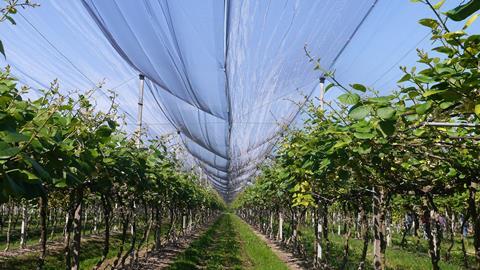Continued decline in production due to moria, frosts and reduction in plantings sees Italian forecast fall again
The volume of kiwifruit produced in both Italy and Greece will be roughly the same this season, according to new figures released by CSO Italy.
Producers in Italy expect a 15 per cent decrease in their national production this season compared with the previous year, due mainly to the impact of the disease known locally as moria.
And while an anticipated crop of 311,000 tonnes enables the country to retain its position as the world’s second-largest producer of the fruit behind New Zealand, an identical forecast volume of 311,000 tonnes for Greece means that it shares that second place in 2023/24.
Five years ago, Italy turned out approximately 373,000 tonnes of green kiwifruit and 60,000 tonnes of yellow-fleshed varieties.
But the impact of moria, especially on the most common green variety Hayward, has been heavy. At the same time, frosts and a reduction in planted area have also contributed to a 7 per cent decline in this year’s harvested volume.
Green gulf, yellow glow
Europe’s total estimated kiwifruit production will be around 755,000 tonnes, 4 per cent less than in 2022 and well below the 800,000 tonnes seen in 2018/19, according to new figures published recently at the 42nd annual conference of the International Kiwifruit Organization (IKO) in Chile.
“Focusing on the forecasts for Italy, the decrease is dictated once again by the reduction in green kiwifruit production, equal to minus 15 per cent compared with the previous year,” CSO stated.
Moria, known outside Italy as ‘die-off’, initially appeared ten years ago in Veneto. In that time, it has had a severe impact on other important kiwifruit growing areas, including Piedmont and more recently Lazio. It is also present in Friuli, Calabria, Campania and Basilicata.
“The phenomenon is very worrying,” says Thomas Bosi of CSO Italy. Based on its own analysis, the group estimates that from 2012 to today more than 8,600ha have been affected by the disease.
Yellow-fleshed kiwifruit appears to have avoided the onslaught, however. This year’s crop could exceed 103,000 tonnes as new plants come into production, and this marks a 12 per cent increase on 2022.
Elsewhere in Europe, Greece’s production is also expected to decline, but by just 3 per cent from last year’s full crop.
The trend is negative as well in Spain, where volumes are set to fall 4 per cent year on year to just over 28,000 tonnes.
France’s production forecast is around 46,000 tonnes (+2 per cent on 2022) and Portugal expects a 10 per cent increase to roughly 58,000 tonnes.
Southern Hemisphere harvests earlier this year were generally well down on the previous season, mainly as a result of climate-related issues.
New Zealand produced about 492,000 tonnes (down 21 per cent), with a marked decline in the green product. Chile recorded an 11 per cent fall to just under 125,000 tonnes.
As a result, it appears less kiwifruit has ended up in Europe and these countries’ campaigns have finished earlier than usual.




